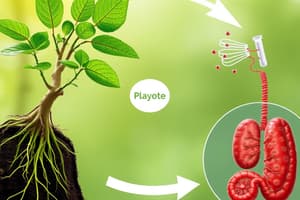Podcast
Questions and Answers
What process do autotrophs use to capture carbon from the atmosphere?
What process do autotrophs use to capture carbon from the atmosphere?
- Cellular respiration
- Combustion
- Photosynthesis (correct)
- Decomposition
Heterotrophs include organisms that produce their own food, like plants.
Heterotrophs include organisms that produce their own food, like plants.
False (B)
What chemical form does carbon exist in when dissolved in water?
What chemical form does carbon exist in when dissolved in water?
bicarbonate
The sediment on the ocean floor eventually turns into __________, which is a major carbon reservoir.
The sediment on the ocean floor eventually turns into __________, which is a major carbon reservoir.
Match the following processes with their descriptions:
Match the following processes with their descriptions:
Which of the following is a long-term carbon reservoir?
Which of the following is a long-term carbon reservoir?
Subduction is a process that can release carbon into the atmosphere.
Subduction is a process that can release carbon into the atmosphere.
What is the process called that uses energy stored in carbon molecules to produce energy?
What is the process called that uses energy stored in carbon molecules to produce energy?
Fossil fuels are formed from the remains of plants that decomposed under __________ conditions.
Fossil fuels are formed from the remains of plants that decomposed under __________ conditions.
Which organisms are classified as autotrophs?
Which organisms are classified as autotrophs?
Flashcards are hidden until you start studying
Study Notes
Rapid Carbon Exchange
- Interconnected cycle involving living organisms, occurring quickly through cellular respiration and photosynthesis.
- CO2 is present in the atmosphere and dissolves in water as bicarbonate (HCO3).
- Autotrophs capture carbon dioxide from air or bicarbonate via photosynthesis and chemosynthesis, transforming it into organic compounds like glucose (C6H12O6).
- Heterotrophs, including humans, obtain organic molecules from producers to utilize carbon in energy release.
- Cellular respiration in both autotrophs and heterotrophs breaks down carbon molecules, releasing CO2 back into the atmosphere.
- Decomposers contribute to the carbon cycle by breaking down dead matter, releasing organic compounds and CO2.
- Rapid carbon cycling is particularly efficient in aquatic ecosystems.
Long Term Carbon Cycling
- Geological processes drive long-term carbon cycling, spanning millions of years.
- Carbon is stored in various reservoirs including the atmosphere, oceans, sediments, and soil.
- Oceanic CO2 levels fluctuate with carbon reservoirs, influencing atmospheric CO2 concentration.
- In oceans, CO2 combines with water to form bicarbonate, which further reacts to produce carbonate ions (CO3).
- Carbonate ions bond with calcium to form shells of marine organisms; upon death, these remains contribute to ocean sediment.
- Over millions of years, sediment transforms into limestone, the largest carbon reservoir on Earth.
- On land, carbon is stored in soil via organic decomposition and the weathering of rocks (inorganic carbon).
- Fossil fuels, formed from ancient plant remains under anaerobic conditions, serve as deep carbon stores.
- Combustion of fossil fuels releases carbon back into the atmosphere as CO2.
- Volcanoes and tectonic plate movements also contribute carbon to the atmosphere through processes like subduction, where sediments containing carbon are shifted and released.
Studying That Suits You
Use AI to generate personalized quizzes and flashcards to suit your learning preferences.




